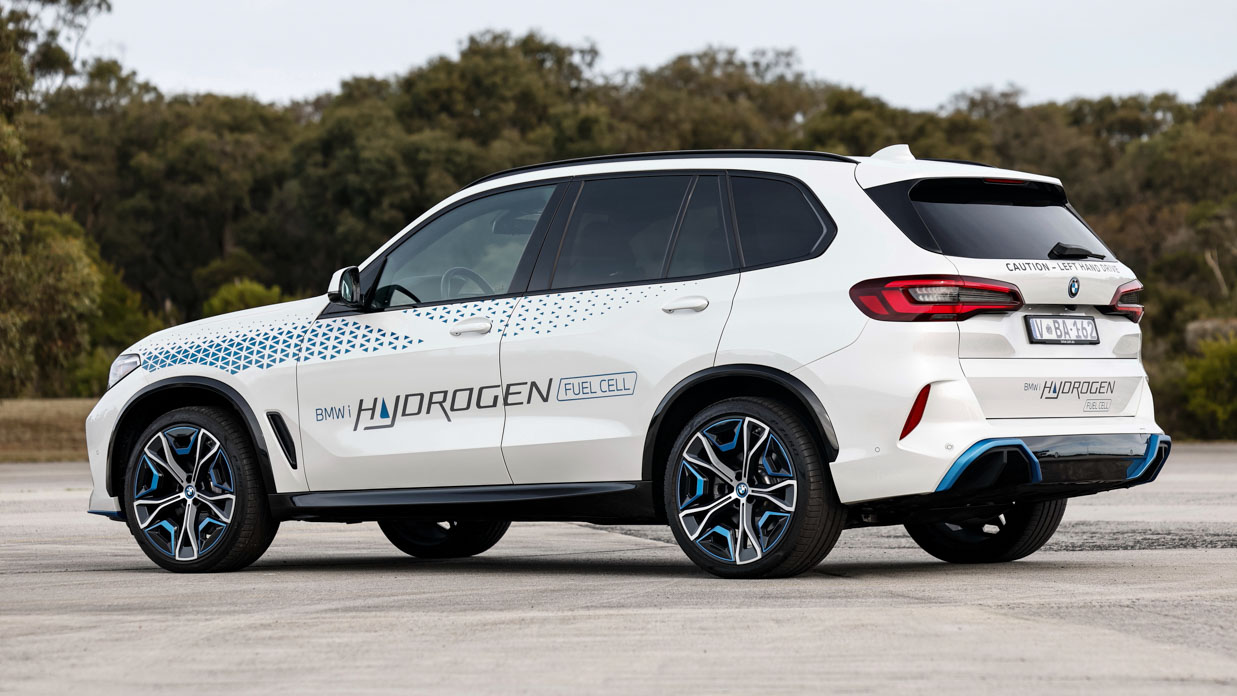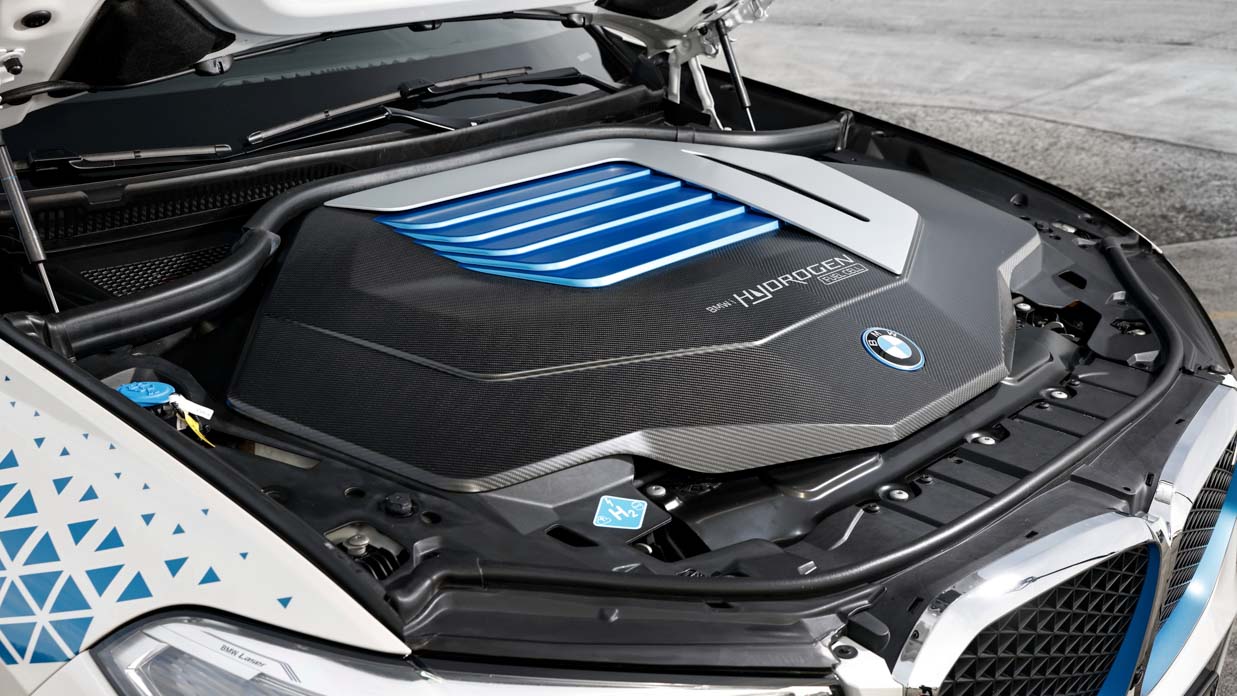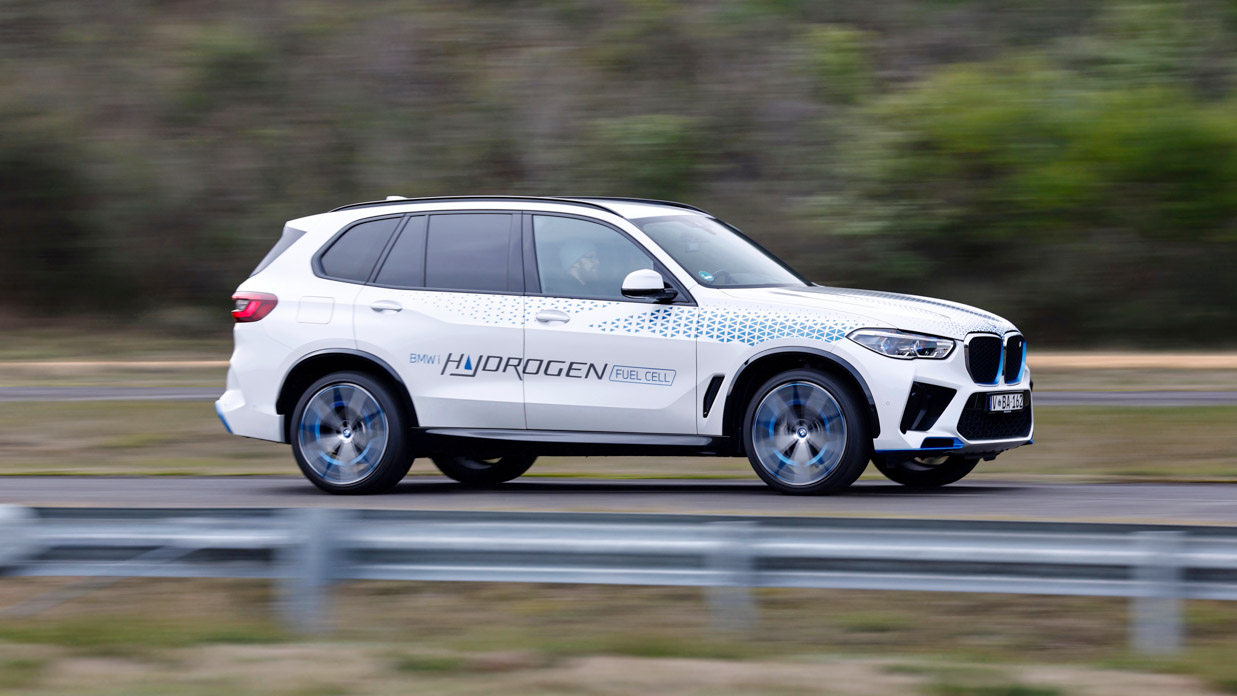-
Car Reviews
- All reviews
- Midsize SUVs
- Small cars
- Utes
- Small SUVs
- Large SUVs
- Large cars
- Sports SUVs
- Sports cars
- Vans
Latest reviews
- Car News
-
Car Comparisons
Latest comparisons
- Chasing Deals
BMW keeps betting on hydrogen and a drive of its iX5 fuel cell prototype leaves us impressed. But there are some massive hurdles to overcome
There’s something familiar about putting your foot down in a hydrogen fuel cell car, even if you’ve never driven one before.
Press the accelerator and a substance is pumped into a mechanical contraption under the bonnet, which combines it with air to produce power.

There’s a waste gas that vents into the atmosphere, while when the fuel gauge approaches “E” you simply pull up at a pump, attach a nozzle and within minutes you’re refilled and good to go again.
Today, this has been our experience driving BMW’s iX5 Hydrogen, a prototype fuel cell electric vehicle (FCEV). To promote its hydrogen vision, BMW has brought two left-hand-drive iX5s to Australia as part of something of a globe-trotting sales pitch.
Like Toyota, Hyundai and some new automotive hydrogen aspirants in China, BMW continues to stack chips on hydrogen despite the seemingly unstopped march of the battery electric vehicle (BEV). And has done for quite some while now.

Of course, the hydrogen story is not a new one. And BMW, for its part, has been working on hydrogen vehicles for 40 years now, the last 10 of which in partnership with Toyota.
But as the sales growth of BEVs starts to splutter in some important markets, the tortuous tale of the hydrogen car has suddenly become that little bit more relevant.
Hydrogen, says BMW, will become an important element of the greater decarbonising of the new car world. We can’t just leave it to BEVs, says the German brand, and hydrogen might still be a smarter bet in the long term.

To be sure, Europe is putting its money where its mouth is, already with 268 hydrogen refilling stations and plans to expand to 600 by 2030. In contrast, Australia currently has eight refilling stations, if with another five under construction.
Still, nothing makes the hydrogen vision feel more within reach than driving a physical car.
The iX5 Hydrogen we’re testing today is effectively an X5 SUV retrofitted with everything it needs to run on hydrogen. A fuel cell goes under the bonnet while two high-pressure tanks sit in a T-arrangement where the transmission and petrol tank once lived. Packaging wise, interior and boot space are unaffected.

The carbon-fibre-reinforced tanks, pressurised to an incredible 700 bar (10,152 psi), store a combined six kilograms of hydrogen, or enough for around 500km of WLTP range.
One of the main advantages of an FCEV is that refilling takes just minutes compared to the vastly longer recharging to top up a BEV. BMW calls its FCEV approach the “EV with fast refuelling”.
But that’s provided you can find a hydrogen refilling station, of course, and are happy to pay somewhere in the vicinity of $120-$170 for a tank at current hydrogen prices (AU$29 as a guesstimate).

The fuel cell itself produces a continuous 125kW – the “world’s most powerful passenger vehicle fuel cell”, says BMW – while an onboard battery mounted at the rear of the car contributes an additional 170kW. Together, total system output is 295kW. Drive is courtesy of a single rear electric motor powering the rear axle.
In the metal, there’s little to differentiate the iX5 Hydrogen from any other X5…save for the giant “Hydrogen fuel cell” decals, but we can’t imagine many speccing these at a dealership.
It’s the same inside, except for a few clues. The digital instrument cluster, for example, reads fuel consumption in “kg H2/100km” – which is cool in a nerdy kind of way.

Our drive of the iX5 Hydrogen was limited to a lap of the ride and handling circuit at the Lang Lang Proving Ground in Victoria, still very much haunted by the ghosts of Holden’s past.
Thumb the ‘on’ button and this iX5 starts silently and moves away noiselessly and smoothly using only its electric motor. If nobody told you it was hydrogen-powered, you’d simply think it was an electric car.
It’s a special feeling, however, to be driving a car powered solely by hydrogen – the same thing that fuels the sun and the stars. (We can only hope the hydrogen in this test car was generated using renewables, and not a big, fat lump of brown coal.)

Plant your foot and this iX5 has decent power, available instantly in a way only an electric motor can, near silently thrusting you back in the seat. Zero to 100km/h takes “less than six seconds”, claims BMW. It’s not slow.
Ride quality, meanwhile, is decent and, in the corners, despite weighing 2450kg, the iX5 Hydrogen just feels like an EV, with good if heavyset handling.
Ease off the throttle and the iX5 slows without needing to touch the brakes, as the car recuperates the energy for later use. An onboard, its 5.0kWh battery and adjustable brake regeneration (via steering wheel paddles) means the iX5 operates as a hybrid – and there’s plenty of incentive to use as little hydrogen as possible, given how pricey this fuel type is.

Between our short drives at Lang Lang, Dr Juergen Guldner, BMW’s global hydrogen boss (who had jetted out as BMW’s nominated hydrogen salesperson) hands us a thin sheet of metal that sort of looks like the head gasket for a four-cylinder engine (without the big holes).
Developed by Toyota, and used by BMW, this is the heart of it all – the fuel cell itself, where the chemistry magic happens.
Dr Guldner explains that air goes in one bit, hydrogen the other, complicated things happen, and the result is a steady stream of electrons ready to race through an electric motor. And with only water vapour as the byproduct.

There’s an injector of sorts, and the system has a cooling system with what sounds like a water jacket. It’s fascinating how similar a hydrogen fuel cell is, in general principle, to an internal combustion engine. Dr Guldner explains.
“A lot of components are very, very similar,” he says. “The suppliers who do exhaust sensors and stuff like that, they can do hydrogen sensors. It’s a 10 percent difference with what they do with the sensors. The cooling system, the air intake system, it’s all the same.
“Only this is different,” he says, pointing to the vehicle’s hydrogen fuel cell stack, “but everything else is combustion engine technology.”

It must be said that with the car industry employing so many people in Germany, the economic and geopolitical appeal of FCEV technology compared to that of a BEV is not lost on us.
Hydrogen proponents also extol its virtuously short refilling time compared to that of recharging a BEV. On that basis, hydrogen vehicles could make more sense for towing. FCEVs also use less rare earth minerals than BEVs and don’t lose range in very cold climates.
But hydrogen’s infrastructure challenges are even greater than those of the electric car. The development of BEV recharging infrastructure has at least a headstart in the form of the existing electricity grid. It will need to be upgraded significantly with BEV uptake, no doubt, but hydrogen in comparison is starting from relative scratch.

Dr Guldner says in the long term, hydrogen infrastructure could be cheaper than totally overhauling the grid for full BEV adoption.
There’s the question of efficiency. To power a hydrogen FCEV, you need to create the hydrogen, for example using electrolysis, which requires electricity. BEVs cut out this middleman of sorts by allowing you to simply recharge the car straight from the power source.
Hydrogen would also need to be shipped and trucked around much like petrol today – a potential export opportunity for nations rich with renewable energy potential, such as Australia – but using energy to transport energy isn’t ideal. Especially if that seaborne tanker transporting the hydrogen is running on fossil fuel.

And don’t mention burning hydrogen. While Toyota has teased some hydrogen combustion engines, and recently began trialling a hydrogen Hiace van – which promise a future-proofed, conscience-cleared exhaust note – burning hydrogen in a passenger car is the kind of idea that makes engineers wince.
If the iX5 burned hydrogen in a combustion engine instead of using it in a fuel cell, it would get 300km of range rather than 500km, says Dr Guldner.
BMW did experiment with hydrogen combustion in the 2000s – even selling a production hydrogen V12 7 Series – but Dr Guldner explains it’s off the company’s radar for now.

“We think for trucks [hydrogen] might actually work,” he muses. “A good interim solution at least [could be] retrofitting a diesel engine to run on hydrogen [which] could be a good thing.
“On a larger scale, things like mining equipment, to decarbonise that, it’s a perfect solution because there, you don’t really need efficiency, you need power, and hydrogen combustion is a great solution.”
It seems those hoping for a hydrogen-combustion, naturally aspirated V8 M3 producing only water vapour as its exhaust can only keep praying. “We simply haven’t looked at it,” says Dr Guldner.

What we do know is that hydrogen-powered BMWs are coming, and lots of them. In his presentation, Dr Guldner showed us a graph demonstrating the almost exponential growth of BMW’s BEV range. From the first MINI E in 2009, there are now 13 electric BMW models, with another four imminent.
Much like the MINI E spawning BMW’s current BEV range, on the other side of the graph there was the iX5 Hydrogen we drove today, with arrows indicating many future fuel cell models coming.
They’ll be here mostly in the 2030s, says Dr Guldner. The first one is hoped to arrive before 2030, so no need to hold your breath too long.

Another somewhat relevant question is how much volume-produced hydrogen fuel cell cars might cost. Dr Guldner was buoyantly bullish.
“I think we would be able to bring the cost into the range that we need to have a commercially viable product,” he says.
Whatever the cost, BMW Australia said it would offer any hydrogen products in Australia.

At the end of our drive in the iX5 Hydrogen, we are feeling optimistic and encouraged – but a bit dispirited. It would take huge efforts to establish a proper hydrogen refilling network, costing a fortune and surely taking decades to establish.
But it seems it’s only a question of time, money and wherewithal, all of which exists for hydrogen, and not just within BMW. The momentum is there.
While it appears that the race to replace fossil fuel passenger vehicles is more a long enduro than a sprint, we wouldn’t write off hydrogen just yet.
About Chasing cars
Chasing Cars reviews are 100% independent.
Because we are powered by Budget Direct Insurance, we don’t receive advertising or sales revenue from car manufacturers.
We’re truly independent – giving you Australia’s best car reviews.
The estimate provided does not take into account your personal circumstances but is intended to give a general indication of the cost of insurance, in order to obtain a complete quote, please visit www.budgetdirect.com.au. Estimate includes 15%^ online discount.
^Conditions Apply
Budget Direct Insurance arranged by Auto & General Services Pty Ltd ACN 003 617 909(AGS) AFSL 241 411, for and on behalf of the insurer, Auto & General Insurance Company Limited(ABN 42 111 586 353, AFSL 285 571).Because we don’t know your financial needs, we can’t advise you if this insurance will suit you. You should consider your needs and the Product Disclosure Statement before making a decision to buy insurance. Terms and conditions apply.
Indicative quote based on assumptions including postcode , 40 year old male with no offences, licence suspensions or claims in the last 5 years, a NCD Rating 1 and no younger drivers listed. White car, driven up to 10,000kms a year, unfinanced, with no modifications, factory options and/or non-standard accessories, private use only and garaged at night.
^Online Discounts Terms & Conditions
1. Discounts apply to the premium paid for a new Budget Direct Gold Comprehensive Car Insurance, Third Party Property Only or Third Party Property, Fire & Theft Insurance policy initiated online on or after 29 March 2017. Discounts do not apply to optional Roadside Assistance.
2. Discounts do not apply to any renewal offer of insurance.
3. Discounts only apply to the insurance portion of the premium. Discounts are applied before government charges, taxes, levies and fees, including instalment processing fees (as applicable). The full extent of discounts may therefore be impacted.
4. We reserve the right to change the offer without notice.